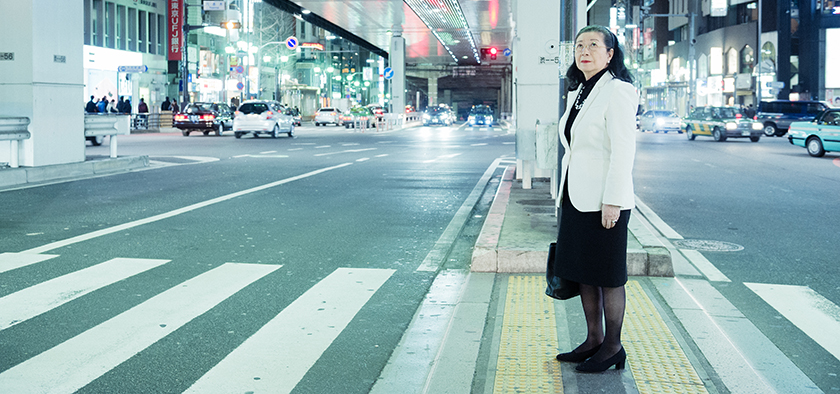
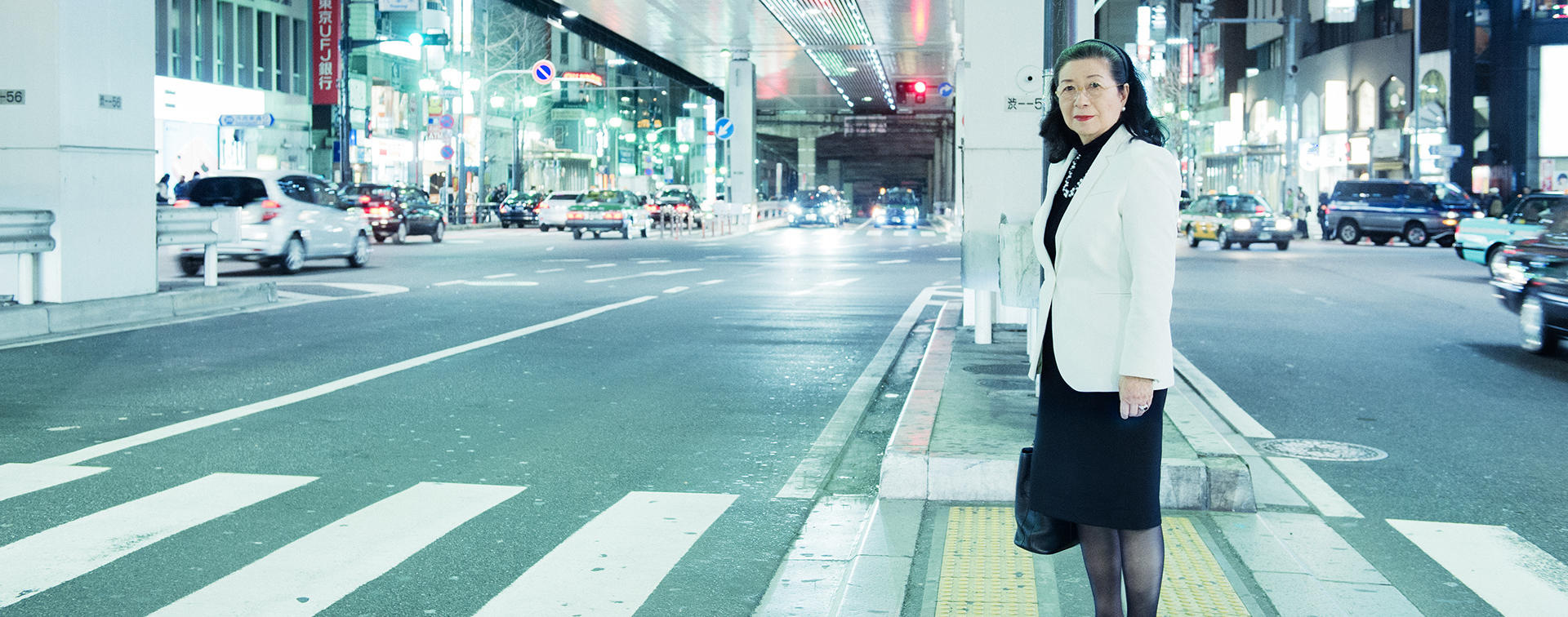

“Something new” to light up the future
A summer festival of lights in Roppongi
Motoko Ishii is a pioneer in Japan in the illumination of architecture, and is known for designing the lights for the Tokyo Tower - whose sight we now take for granted - as well as the Roppongi Hills Mori Tower and the Tokyo Gate Bridge. Ishii, who also designed the lights installed under the elevated express way, has strong ties with Roppongi. We asked her about her memories of the area in the 1970s as well as some of the steps she would like to see implemented in Roppongi.
An inconvenient yet cozy place
In the 1970s, I opened my first office on the "Kyu TV Asahi Dori" (the Former Asahi TV Street) in Roppongi. I chose Roppongi because in those days it was more affordable to have an office here than in Shinbashi or Ginza. There was only one subway line - the Hibiya Line, and while being an inconvenient location, Roppongi was for some reason an extremely comfortable place for designers.
On the Kyu Tele-Asa Dori, there was a variety store commonly known as "Azabu Yours" which was open until 5 a.m. and a lot of camerapersons and designers came shopping late at night. And people who had been drinking in Ginza or nearby would later come to Roppongi for more drinks. Even in those days, many shops were open until dawn, so everyone came here to have noisy fun.
In the basement below my office was an establishment called "Speak Low" which Shiro Kuramata-san had designed, and Kishin Shinoyama-san and all kinds of people went there. There was also Chianti, the famous Italian restaurant where I would often get together with people such as Kisho Kurokawa-san and Tadanori Yokoo-san. We would usually begin at around 10 in the evening and stay until daybreak. (laughs) There's a book I read called "Chianti Monogatari" (written by Tsuneyoshi Noji and published by Gentosha) which brought back fond memories.
Roppongi was "rural" in the 1970s
With its many embassies and people from all around the world, Roppongi had an international atmosphere in those days too. But if you walked one street behind the main street, you would find yourself in a very ordinary, residential neighborhood. It was a very approachable area where different elements were jumbled together; I think that in a way, it was a "rural" place. When you look at the map of Roppongi in the Edo era, you see that there used to be a road which looks exactly like the current Kyu Tele-Asa Dori. On the road where the residence of a "hatamoto" samurai used to be, there was a gardener's shop, and an idyllic atmosphere pervaded the place.
Then Roppongi Hills was built and Tokyo Midtown was built, and the area was changed quite extensively. But not everything has been renewed- some old things have been retained such as the Minato Shichifukujin, and I think Roppongi has become a very pleasant area. What is unfortunate though, is that many charming place names have disappeared. The area around the Nishi-Azabu intersection used to be called Kasumicho (mist town) and there was also a place called Kogaicho whose kanji character is"kanzashi" (hair ornament).
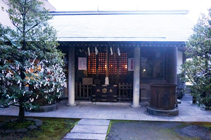
Minato Shichifukujin
Minato Shichifukujin refers to the eight shrines in Minato City such as the Sakurada Jinja (Shirine) on TV Asahi Dori (photo) which enshrine the Seven Lucky Gods and treasure ships. In the New Year, people make a three-hour long pilgrimage to collect stamps from each of these shrines and pray for good fortune and safety of the household.
As you can tell from the fact that many creators have offices in Roppongi, people in my kind of profession find this area a very comfortable place to live in. I relocated my office a long time ago, but I still live in Nishi-Azabu, and Roppongi is my neighborhood; I come walking here on the weekends, dressed in casual clothes. The drawback however, is that I run into a lot of acquaintances. (laughs)
Lights to make the Roppongi intersection identifiable
I designed the lights for the elevated expressway at the Roppongi intersection because I was given the offer by the people of the local shopping district. The aim was to make Roppongi an area of design and art, and they asked me if I would be interested in making something artistic for the intersection - doing something to go with the new Roppongi logo designed by art director Kaoru Kasai-san.
LED lights had just begun to be available at that time, and I suggested that we use them to light up the intersection and make it identifiable. The intersection can be seen by everyone walking in the streets, but when you are passing by in a car, it's difficult to know where you are exactly, isn't it? So I thought it would be good if there were lights to make it instantly clear to car passengers that they were in Roppongi. And I didn't want the lights to be too bright and glaring. My hope was that the lights would make the intersection look nicer even if only in a small way.
Fortunately, the lighting was very well received and after that, I was asked to design the street lamps on Roppongi Dori Street. As you can see, the street lamps go with the lighting of the intersection - they belong to the same family. There was another plan, but the people at the shopping district strongly supported my idea.
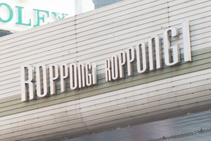
Roppongi logo mark
The logo mark evokes tree-lined streets and was designed by Kaoru Kasai, an art director known for making creative commercials such as those for Suntory Oolong tea. When the Roppongi intersection was renovated in 2009, the logo was installed on the elevated expressway together with the LED lights designed by Motoko Ishii.
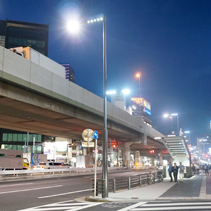
Street lamps on Roppongi Dori Street
In an ongoing project, street lamps are being installed from Ark Hills to Roppongi 6- chome as part of the Tokyo metropolitan government's plan to improve Roppongi's symbolic road. The lamps are of elegant and pleasing design, with five diamond-like white lights set in its arms.

Always trying to incorporate "something new"
"Something new" is my motto; when making things, I always try to incorporate a new element. After all, illumination design is based on the two wheels of art and technology. The new element at the Roppongi intersection was the LED lights. Recently, I made an artwork using the latest OLED lights which emit two colors at the same time. The work will be displayed at a trade fair in Frankfurt, Germany. It's called "OLED COSMOS" and it looks as if thousands of lights are fluttering.
With the Tokyo Gate Bridge near Odaiba that opened in 2012, the new element was the method of illumination. LED lights were placed on the sides of the bridge, and by lighting up each bar of the truss, I tried to give a rich appearance to the framework. Also, a device was installed to change the color of the lights every month.
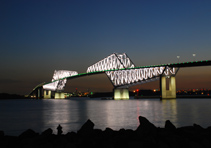
Tokyo Gate Bridge
A bridge connecting Wakasu, Koto ward with Jonanjima, Ota ward. After nine years spent on design, the bridge opened in February 2012. Its illumination began in April of the same year. Of environmentally-conscious design, the bridge has a solar power generating facility. The lights change with each month, turning for example, into light green in March and into orange-red (of autumn leaves) in November.
I've been so absorbed with creating new things that the years have flown by so quickly. (laughs). Illumination is not just about making a piece of architecture look gorgeous - you also need to think about how to present its structure, so this job has quite a practical side to it. Architecture can be just about the building itself, but my job is the kind of job that cannot stand on its own - it is dependent on having something to light up. So that's sometimes the rather difficult part of my work.
The world is visible thanks to the light
I happened to design a piece of lighting equipment when I was young, and it was this experience which led me to this job. Seeing the light glow on the equipment I had designed, I thought to myself, "Ah, how awesome light is." Without light in this world, we would not be able to see the colors or shapes of things. Perhaps light is like the air and is something we are not usually aware of. But I realized that the world around us is visible thanks to the light.
So I went to Finland to study designing lighting equipment. Then to expand my horizons, I went to Germany to study architectural illumination. In European countries such as Germany, France and Britain, electricity has been used to light up the streets since the 1920 and 1930s. Because of this tradition, there were careers in illumination.
The illumination of Tokyo Tower in 1989
I returned to Japan after about two years of study, but I had a really tough time making people understand the power of illumination. It's not something that can be relayed through verbal explanation. And because of its large scale, a work of illumination is not something you can easily create on your own and show to people. I was at a loss as to what to do, but I started by making small lighting equipment.
Illumination began to gain public recognition in Japan in 1989 when the Tokyo Tower was lit up. Until then, hardly anyone had thought of the Tokyo Tower as being beautiful, but the illumination caught everyone by surprise. They saw then that lights can drastically transform the impression of things. It was after its illumination that the Tokyo Tower became a symbolic presence. People who have come from other regions think of the tower as being Tokyo's landmark, and there are also many people who say that when they look at it, they get nostalgic, warm feelings. Someone noted that with its wide base, the tower looks like a lovely votive candle.

Illumination of Tokyo Tower
To mark the 30th anniversary of its opening, the Tokyo Tower was illuminated for the first time in 1989, using projectors to light up the legs of the tower. The photo is of the "diamond veil" illumination for the tower's 50th anniversary which saves energy by 25%. The illumination became a conversation topic for creating traffic jams.
The 1990s was a time when large bridges were built all over Japan, so I was given a lot of work, and I am apparently a lighting designer who has undertaken illumination of the biggest number of large-scale bridges in the world. I started by designing lighting equipment and gradually spread out to other things, eventually designing illumination for cities. Illumination became popular after the year 2000, so its history in Japan is only about 10 years or so, but I'm truly glad to think that tens of thousands of people come to look at an illumination in just one night.
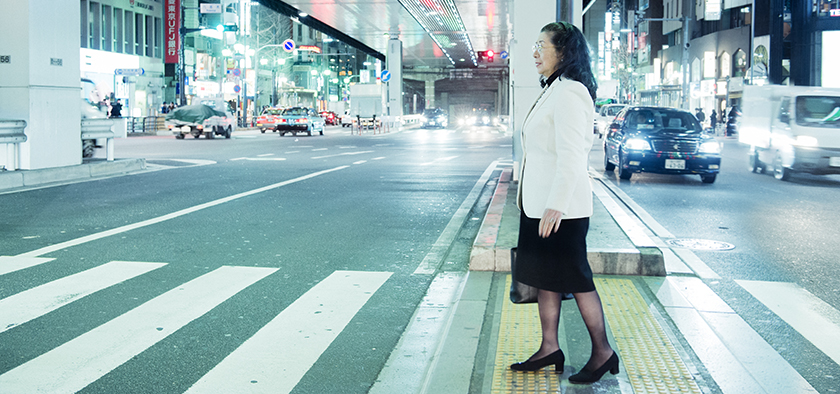
The joy of owning a home power generator
I have a solar power generator at home not exactly because I do work that involves electricity, but I wanted to be able to sell electricity in the daytime and use electricity in the evening without feeling any scruples. Doing this sort of thing in Nishi-Azabu is kind of crazy, isn't it? (laughs). Home solar power has become widespread now, but I got mine in 1998, so I was among the first owners.
I'm always thinking about ways to use natural energy. The Tokyo Gate Bridge I mentioned earlier has a huge solar electricity generator. The illumination at the island of Ganryujima which the site of the duel between Sasaki Kojiro and Miyamoto Musashi, is entirely powered by electricity generated at the island. After the 3.11 Great East Japan Earthquake, the first activity I was involved in was a project to write messages on the Tokyo Tower using solar powered lights.
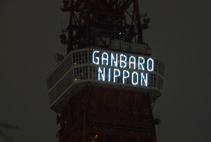
Light message project
Following the Great East Japan Earthquake, a solar panel was placed below the tower, and electricity generated from this panel was used to light up messages on the main observatory. A month after the disaster, the message was "Ganbaro Nippon" (Let's do our best, Japan). In May, it was "kokoro tsunageyo" (Join our hearts) and a year later on March 11, it was "Kizuna Nippon" (Bond Japan)
A big performance is scheduled to take place in October in Berne, Switzerland, and at a preparatory meeting, I told my Swiss counterparts that I wanted to use natural energy. They laughed and said that all their electricity is generated by natural energy now. Consumption of electricity has not grown in recent years due to advances made in energy-saving methods. Home solar generators provide enough energy for lights, so I hope that everyone will use them. It feels really good to be able to generate your own energy.
An international, future-oriented area that retains traditional elements
The other day, a friend of mine from France expressed a wish to go to an onsen (hot springs) so I took him to Atami. The moment we walked out of the station, he exclaimed, "What is the matter with this town?" He was indignant that despite the wonderful onsen and seaside, the town had not been developed according to a proper plan. Indeed, it does seem as if Japanese towns such as Shinjuku and Shibuya have been developed without much thought. Ginza is about the only place where there is a grid plan and the streets are neatly laid out and easy to follow.
Fortunately, in Roppongi, due to the two large development projects of Roppongi Hills and Tokyo Midtown, the Mohri Garden and the Hinokicho Park were retained. There is also ample greenery and the streets have been improved. In developing Roppongi, I think the characteristics of the area should be kept in mind; respect should be paid to its history while at the same time, the streets should be international and future oriented.
There must still be many people who do not have a very good impression of Roppongi. While the main streets are nice now, the backstreets leave a lot to be desired. They are scattered with flyers and filled with electric wires and communication cables. And the street lamps in the various shopping districts are of different colors and designs... As a resident of Roppongi, I think it' a big shame. The intersection has been spruced up, so I think it would be good if the sidewalks were improved and trees planted along the streets; the scenery of the area as a whole could be tidied up and integrated a little more.
Living creatures are instinctively drawn to the light
I hope to participate in events held in Roppongi such as Roppongi Art Night. Once, we did an experiment to make a "tower of light" by projecting light from three spots -Roppongi Hills, Tokyo Midtown and the National Art Center, Tokyo. But this project didn't take off because the lights in the streets were too bright. When the weather is humid, high-rise buildings make the air around them bright as well. I personally think that a town looks lovelier when the air above the eye level is dark... If more powerful lights become available, I hope to take up the "tower of light" project again.
In the winter, pretty illumination events are held in almost any town you go to, so how about holding illumination events in the summer? When the days are long, people spend their time out until late at night, and there is the old tradition of "yusuzumi" (where people cool down outdoors on summer evenings). Holding a summer festival of lights might be a good idea.
It is the instinct of living creatures to gather around lights. Fish are attracted to fishing lights and insects are likewise drawn to the light. So it's natural for human beings to gather around works of illumination and red lanterns (of drinking establishments). It makes sense when you think about, it doesn't it? Wherever there are lights, people want to go near them. It's very simple. (laughs)
Editor's thoughts
Ishii-san's comments at the final part of the interview were made when we were driving toward the Roppongi intersection. Ishii-san said "It's very simple" while watching the people gathering around the illuminations. I could not help reflecting on Ishii-san's remarkable professionalism and the vigor and steadfastness with which she had overcome the times when people did not fully understand what illumination was about.(edit_kentaro inoue)



















